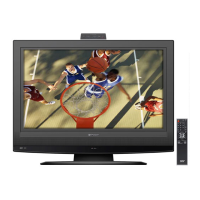
Do you have a question about the Emerson EWL3706 A and is the answer not in the manual?
| Screen Size | 37 inches |
|---|---|
| Display Technology | LCD |
| Resolution | 1366 x 768 |
| Aspect Ratio | 16:9 |
| Contrast Ratio | 1200:1 |
| Brightness | 500 cd/m² |
| Response Time | 8 ms |
| Speakers | 2 x 10W |
| Viewing Angle | 178° |
| Inputs | HDMI, Component, Composite, RF |
Covers reading instructions, cleaning, avoiding water, using accessories, and ventilation.
Covers power sources, grounding, cords, antenna, and lightning protection measures.
Includes FCC statement on radio frequency energy and electrical shock prevention cautions.
Information for CATV installers on grounding and guidelines for recycling and battery disposal.
The user guide for the television, detailing its features and operation.
The device used to operate the TV remotely, including its batteries.
Covers DTV/TV/CATV reception and connectivity via HDMI, Component, S-Video, and AV inputs.
Features for channel scanning, content blocking, closed captioning, and audio selection.
Details the purpose and operation of each button on the TV's remote control.
Describes the buttons located on the TV's top and rear panels for basic operations.
Detailed description and location of all input and output jacks on the TV for connectivity.
Step-by-step guide for correctly installing batteries into the remote control unit.
Instructions for connecting the TV to a home antenna using coaxial cables.
Instructions for connecting the TV to a cable company without a set-top box.
Connecting devices like DVD players using HDMI cables for high-quality audio/video.
Using an HDMI-DVI conversion cable to connect devices with DVI output to the TV's HDMI input.
Connecting to component video jacks for enhanced picture quality, using component and audio cables.
Connecting to S-Video jacks for good picture quality, using S-video and audio cables.
Connecting to standard video and audio jacks for basic video input.
Connecting to digital and analog audio devices using coaxial or audio cables.
Guides through selecting language, confirming antenna source, and autoscan for channel memorization.
Explains how to activate and use the Autoscan feature to find available channels.
Allows users to remove unwanted channels from the TV's channel list.
Instructions for manually adding channels not memorized during Autoscan.
Shows the signal strength for each channel, applicable only to antenna signals.
Allows selection of display language for menus and on-screen prompts.
Explains methods for selecting channels using the remote control or TV panel buttons.
Guides on adjusting the TV's audio volume and using the mute function for sound.
Allows freezing the current TV image, with audio continuing.
Instructions on how to cancel the still image function by pressing any button.
Guides on switching audio modes (Stereo, Mono) for analog TV broadcasts.
Guides on selecting audio languages or secondary audio programs for DTV broadcasts.
Explains how to use the remote control to select various input sources like Video1, Component1, HDMI.
Details the information displayed on screen when accessing external devices.
Explains how to select different screen display modes for 4:3 and 16:9 signals.
Displays channel number and audio mode for analog TV signals.
Shows detailed program information, broadcast station, audio language, and other data for DTV.
Allows setting an automatic shut-off time for the television after a set period.
Provides an overview of the setup screen and its main function categories.
Allows selection of picture modes and adjustment of brightness.
Adjusting contrast, color brilliance, and tint for natural skin tones.
Adjusting sharpness, color temperature, and energy-saving settings for optimal viewing.
Options for viewing closed captions on TV programs and tapes, including modes like Pop-on and Roll-up.
Settings for DTV closed captions, including selecting services and modes.
Options for customizing the font, size, color, and opacity of closed captions.
Instructions for setting up a password and blocking specific content ratings for children.
Configuring MPAA and TV ratings to block or allow programming based on age and content.
Options to select Auto, Digital, or Analog audio input methods for HDMI connections.
Guides on how to securely attach the TV to a wall mount bracket.
Provides remedies for common problems like no power, distorted picture, or poor sound quality.
Addresses issues related to weak reception, lines, picture blur, and bars on the screen.
Offers solutions for caption display errors and troubleshooting the remote control.
Defines common TV and technology terms like ATSC, HDMI, Aspect Ratio, and NTSC.
Guides on safely cleaning the TV cabinet and LCD screen using appropriate methods.
Advice on when to get professional service and how to test the remote control's infrared signal.
Lists general specifications including TV system, channel coverage, tuning system, and terminal types.
Provides electrical specifications, power consumption, dimensions, and weight of the TV.
Details the warranty period for parts and labor, including exclusions.
Outlines what damages and conditions are not covered by the product warranty.
